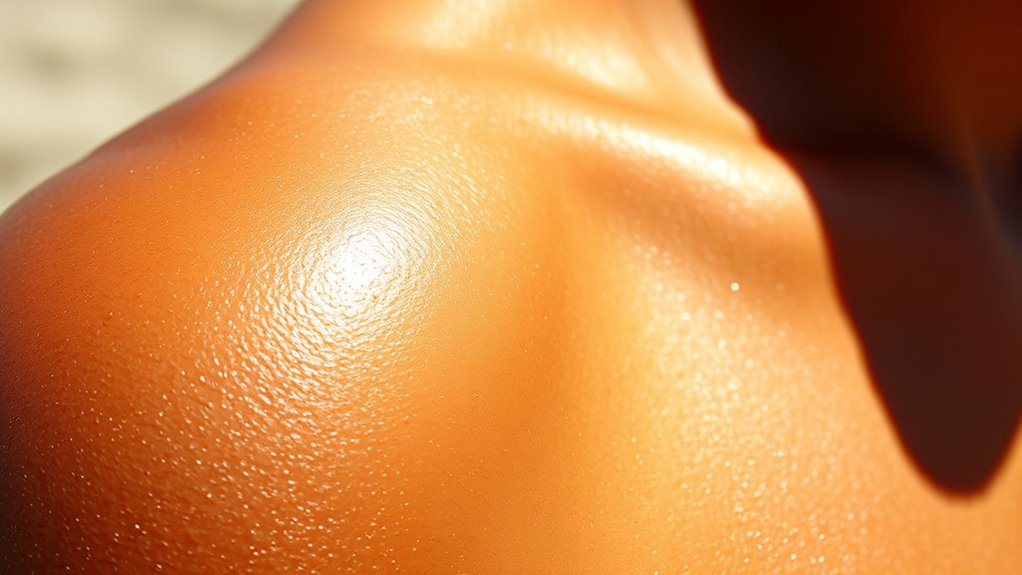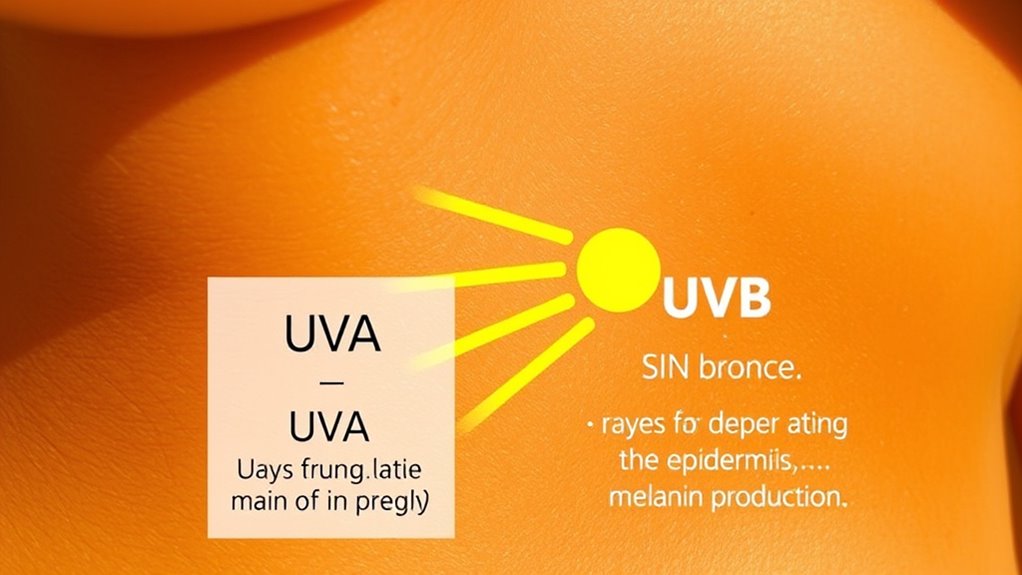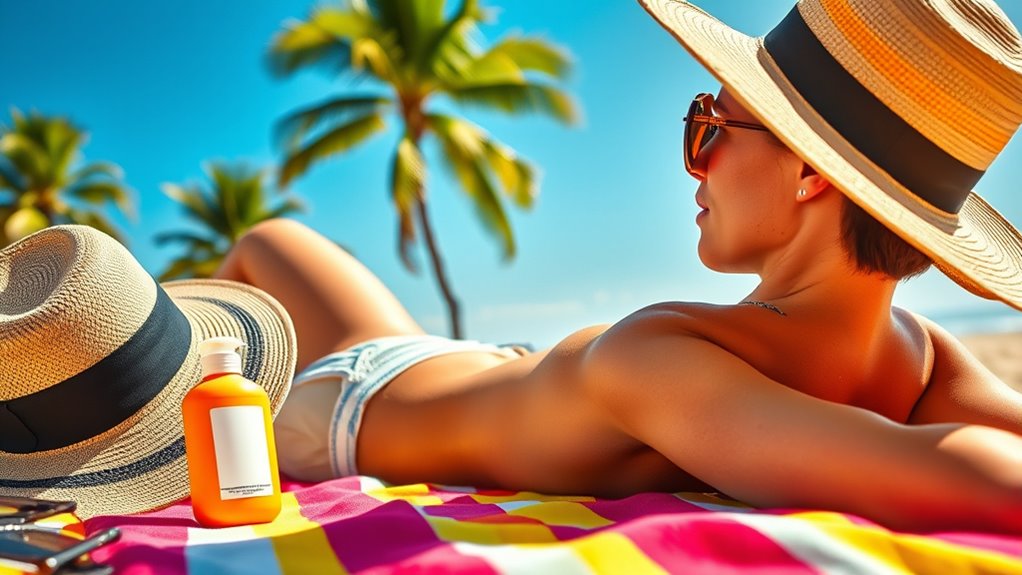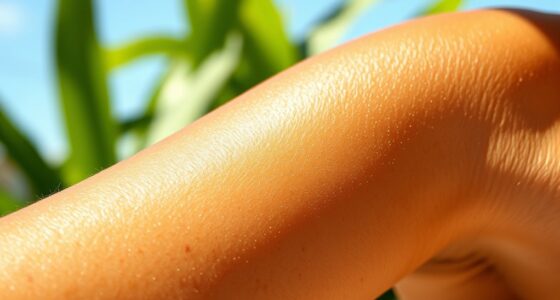Your skin tans as a biological response to UV rays, mainly UVA and UVB, which trigger protective mechanisms. Melanin production increases, with melanosomes migrating to skin cells to shield DNA from damage. Tanning helps preserve important nutrients like folate and regulate vitamin D synthesis. It’s an evolved defense to reduce skin harm and support survival. But if you want to understand how this natural process works and its risks, keep exploring further.
Key Takeaways
- Tanning is an adaptive biological response to UV exposure, aiming to protect skin cells from UV damage.
- Melanin production, triggered by UV radiation, darkens the skin to absorb and scatter harmful UV rays.
- Tanning helps preserve folate levels vital for reproduction and cell division by reducing UV penetration.
- It regulates vitamin D synthesis, balancing exposure to maintain health without excessive damage.
- Tanning signifies skin injury and damage, evolved as a protective mechanism despite indicating stress to the skin.
How UV Radiation Triggers Skin Darkening

When your skin is exposed to UV radiation, it triggers a series of rapid and longer-term responses that lead to skin darkening. Immediately, UVA rays cause immediate pigment darkening (IPD) by chemically modifying existing melanin and redistributing melanosomes within keratinocytes and melanocytes. This results in a blotchy, bluish-gray tint on sun-exposed areas, providing quick, superficial UV protection. At the same time, UVB rays damage DNA in keratinocytes, activating a molecular cascade. This process involves the production of α-MSH from POMC, which then stimulates melanocytes. As a result, melanocytes produce new melanin, which is transferred to keratinocytes. These melanosomes move and cluster above the nucleus, forming protective caps that shield DNA from further UV damage, leading to longer-lasting skin darkening.
The Role of Melanin in Protecting Skin Cells

Melanin plays a crucial role in shielding your skin cells from harmful ultraviolet (UV) radiation. It absorbs UVA, UVB, UVC, and blue light across a broad spectrum, acting as a natural defense. Melanin scatters UV rays, reducing their penetration into the epidermis, which helps prevent cellular damage. Darker skin, rich in eumelanin, offers superior protection compared to lighter skin with pheomelanin. When exposed to UV, melanin converts absorbed energy into heat, minimizing DNA damage within skin cells. This process lowers your risk of skin cancers and other UV-induced disorders. Although melanin provides some natural protection, it isn’t enough alone, so using sunscreens and protective clothing remains essential for complete defense against sun damage.
Differences Between UVA and UVB Rays and Their Effects

UVA and UVB rays are the two main types of ultraviolet radiation from the sun, each affecting your skin differently. UVA makes up about 90-95% of UV radiation reaching Earth and penetrates deep into your skin’s dermal layers. It’s mainly linked to premature aging, skin damage, and indirectly to skin cancer. UVB, although only 5-10%, has higher energy and shorter wavelengths. It primarily affects the outer skin layers, causing sunburn and directly increasing skin cancer risk. UVB is more intense during peak sun hours and summer months. While both types can harm your skin, UVB acts quickly and causes immediate damage, whereas UVA contributes gradually over time. Protecting yourself requires broad-spectrum sunscreen and other measures to block both UVA and UVB rays. Understanding the types of ultraviolet radiation and their effects can help you make better choices for skin protection. Additionally, being aware of how appliance energy consumption impacts overall energy use emphasizes the importance of sun protection in conserving resources. Recognizing the seasonal variation in UV exposure can also aid in planning effective sun safety strategies.
The Evolutionary Purpose Behind Tanning

Tanning evolved as a key protective response to the sun’s ultraviolet radiation, helping your ancestors prevent skin damage while still enabling essential vitamin D production. It acts as a natural defense, reducing UV damage to skin cells and preserving folate levels, which are crucial for reproductive health and cell division. Tanning also allows for regulation of vitamin D synthesis—limiting UV exposure while maintaining enough for health. This adaptive trait developed independently in regions with fluctuating UV levels, offering a survival advantage. In mid-latitude areas, seasonal tanning protects against high UV exposure, while in northern regions, it helps optimize vitamin D production despite limited sunlight. Overall, tanning reflects an evolutionary strategy to balance UV protection and vitamin D needs, enhancing survival in diverse environments. Additionally, it can signal an individual’s adaptive response to environmental UV levels, demonstrating the body’s ability to respond to changing conditions.
The Biological Process of Melanin Production

The process of melanin production, known as melanogenesis, involves a series of chemical reactions that transform the amino acid tyrosine into the pigment responsible for skin color. It starts when the enzyme tyrosinase catalyzes the oxidation of tyrosine within melanosomes—specialized organelles in melanocytes. These organelles are responsible for synthesizing, processing, and storing melanin. During this process, tyrosinase converts tyrosine into dopaquinone, which then polymerizes into eumelanin or pheomelanin, depending on additional enzymatic steps. Melanin is then packaged into melanosomes, which migrate to the tips of melanocyte dendrites. From there, these melanosomes are transferred to keratinocytes in the skin, providing pigmentation and protection. Factors like UV exposure and genetics regulate this intricate process, and recent studies highlight the role of AI-driven security systems in protecting sensitive data related to skin health. Additionally, genetic factors play a significant role in determining individual variations in melanin production and skin color. The regulation of melanin synthesis is also influenced by hormonal signals, which can accelerate or inhibit the process depending on the body’s needs. Studies suggest that environmental influences can significantly modify melanin synthesis, leading to variations in skin response. Understanding the biological mechanisms behind melanin synthesis helps explain why skin reacts differently to environmental stimuli.
How Melanin Distribution Shields Deeper Skin Layers

Melanin’s strategic distribution within the skin plays a vital role in protecting its deeper layers from ultraviolet (UV) damage. Most melanin is concentrated in the basal layer of the epidermis, where melanocytes produce it, and keratinocytes receive and store it. This positioning allows melanin to form supra-nuclear caps in keratinocytes, shielding DNA from UV rays. Active transport mechanisms, guided by cytoskeletal elements, ensure melanin granules stay above the nucleus, providing effective protection. By limiting melanin’s upward movement, the skin retains pigment where it’s needed most, preventing UV-induced mutations in proliferative cells. The concentration of eumelanin in basal keratinocytes enhances UV absorption and antioxidant defenses, especially in darker skin tones. This distribution pattern optimizes the skin’s ability to defend against DNA damage and oxidative stress deep within. Additionally, the distribution of melanin is influenced by genetic factors that regulate melanocyte activity and pigment synthesis, contributing to individual variations in skin protection. Recent studies also highlight how AI-driven analytics can help improve understanding of these biological mechanisms, leading to better skin cancer prevention strategies. Understanding these mechanisms can also inform skin cancer prevention strategies and treatments.
Tanning as a Defense Against Skin Damage and Cancer

When your skin is exposed to UV rays, it responds by producing more melanin, which acts as a natural barrier against the harmful effects of radiation. Melanin absorbs UV rays, reducing DNA damage and lowering the risk of genetic mutations that can lead to skin cancer. It also creates a protective barrier, preventing UV rays from penetrating deeper into your skin and causing further harm. Tanning is an adaptive response, aiming to shield your skin from additional damage. Additionally, the role of quotes about fatherhood in the skin’s response help ensure that melanin production remains effective across diverse skin types. However, while melanin offers some protection, it’s not foolproof. Tanning still indicates skin injury, and over time, repeated exposure accumulates damage. This increases your risk of skin cancer, premature aging, and genetic mutations, emphasizing that tanning is more a sign of skin stress than a safe defense. Controversy surrounding mammography highlights ongoing debates about the effectiveness of protective responses and early detection strategies.
The Balance Between Sun Exposure and Vitamin D Synthesis

Balancing sun exposure to optimize vitamin D synthesis while minimizing skin damage requires understanding how much time in the sun is enough. For most people, 4 to 15 minutes of midday sun exposure several times a week is sufficient. Those with darker skin need slightly more time because higher melanin levels reduce UVB penetration. In lighter skin types, about 8 to 10 minutes at noon typically produces the recommended vitamin D levels. Exposing your face, hands, and arms for roughly half the time it takes to burn—around 12 minutes in UV index 7 conditions—can generate enough vitamin D. Remember, prolonged exposure beyond this mainly increases skin damage risk without boosting vitamin D production. Short, regular sun sessions are key to maintaining healthy levels safely. Understanding skin types can help tailor sun exposure to individual needs. Additionally, individual factors like skin sensitivity can influence how quickly skin reacts to UV exposure.
Common Misconceptions About Tanning and Skin Health

Many people believe that getting a base tan can protect them from sunburn and skin damage, but this isn’t true. A base tan results in only a slight increase in melanin, offering an SPF of about 4 or less, which isn’t enough to prevent sunburn. Both tans and burns are caused by UV-induced DNA damage, so no tan is truly safe. A tan reflects the skin’s attempt at self-protection against UV damage, but it is insufficient to prevent harm. Relying on a tan can give you a false sense of security, leading to riskier sun behaviors. Remember, UVA rays also damage skin and increase cancer risk—they’re not just the UVB rays responsible for burning. Dermatologists agree that no level of tanning prevents the carcinogenic effects of UV radiation. Indoor tanning is equally dangerous, with studies showing it accelerates skin aging and raises skin cancer risks. Understanding your skin’s vibrational state can help explain why the body responds negatively to UV exposure, emphasizing the importance of protecting skin health. Additionally, the biological response of skin cells to UV radiation involves complex processes that lead to aging and potential malignancies, highlighting why any tanning is harmful. New research into cellular mechanisms shows how UV exposure overwhelms the skin’s protective mechanisms, leading to long-term damage.
The Impact of Artificial Tanning Methods on Skin Biology

Artificial tanning methods directly influence skin biology by activating melanocytes to produce melanin, mimicking the natural response to UV exposure. Sunless products containing DHA and erythrulose react with skin proteins through the Maillard reaction, creating a tan without UV light. However, DHA can penetrate beyond the outer dead layer, reaching living skin cells, which may cause DNA damage, cell-cycle arrest, and apoptosis. The reaction also generates free radicals, leading to oxidative injury and increased skin vulnerability, especially with frequent use. Tanning beds emit UV radiation that triggers melanin production but also causes DNA mutations, skin aging, and cancer risks similar to natural sun exposure. Overall, artificial tanning methods alter cellular processes, promote oxidative stress, and contribute to long-term skin damage.
Frequently Asked Questions
Can People With Darker Skin Avoid UV Damage Despite Increased Melanin?
You might wonder if darker skin can fully avoid UV damage due to its higher melanin levels. While your skin provides better protection by absorbing and reflecting UV rays, it doesn’t block all UV radiation. Prolonged or intense sun exposure can still cause damage, including skin aging and even skin cancer. To stay safe, always use broad-spectrum sunscreen, seek shade, and wear protective clothing, no matter your skin tone.
Does Tanning Permanently Change Skin’S Melanin Levels?
Think of your skin’s melanin levels as a tide that rises with UV exposure but then recedes. Tanning doesn’t permanently change these levels; it’s like a temporary shadow cast by the sun. Your melanocytes produce more melanin during UV exposure, but once you step away from the sun, levels go back to baseline. Repeated tanning can cause some lasting dark spots, but overall, melanin levels remain largely unchanged long-term.
How Quickly Does Melanin Production Begin After UV Exposure?
After UV exposure, you start producing melanin very quickly, especially from UVA rays. Your skin activates existing tyrosinase enzymes within 1 to 4 hours, thanks to a retinal-dependent mechanism. This rapid response helps protect your skin by creating a protective pigment barrier. In contrast, UVB causes a delayed response, taking over 12 hours to begin new melanin synthesis. So, your skin reacts promptly to UV damage with early melanin production.
Is Natural Tanning More Protective Than Artificial Tanning Methods?
Think of your skin as a shield, evolving to defend you against harmful rays. Natural tanning offers a slight edge, as sun exposure encourages your body to produce melanin gradually, providing limited protection. Artificial tanning, however, is like putting on a thin, brittle armor—no real defense. While natural methods may offer marginal benefits, neither fully guards you. Always layer with sunscreen, because true protection comes from awareness, not just a tan.
Can Melanin Production Be Influenced or Enhanced Intentionally?
You can intentionally influence or enhance melanin production through various methods. By increasing sun exposure safely, you stimulate melanin synthesis naturally. Consuming foods rich in antioxidants, vitamin C, and minerals support skin health and pigmentation. Topical treatments, like vitamin C serums or retinoids, may also boost melanin levels. Additionally, supplements such as L-tyrosine can promote melanin production, helping you achieve a darker, more even skin tone.
Conclusion
So, next time you see your skin turn a little darker, remember it’s not just a tan — it’s your body’s mighty shield, fighting off invisible invaders and trying to keep you safe from harm! Tanning is your skin’s superhero move, a brilliant defense that’s been hardwired into you for thousands of years. Embrace it wisely, because ignoring nature’s genius could leave you vulnerable in ways you can’t even imagine!









